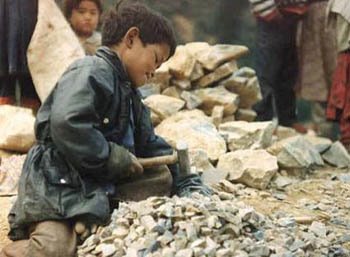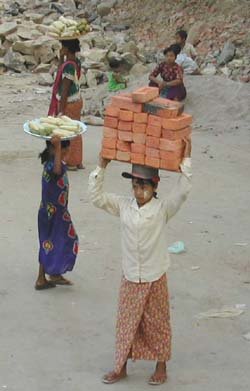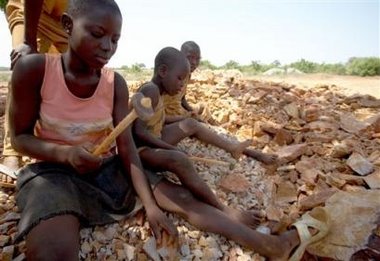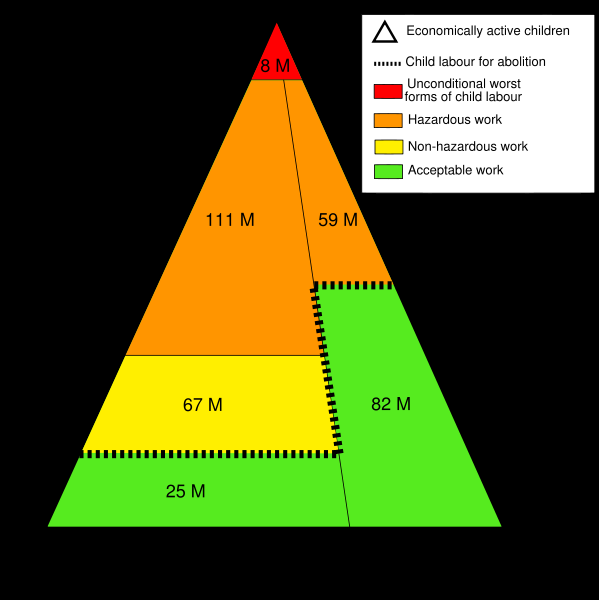Here is an article on the punishments incurred by the employers of children in Benin.
Let us take the case of Benin in Black Africa. Benin is the moving plate of children's traffic. Indeed, certain families which can not put their children in schools for lack of means, entrust their children to "boatmen" who say to them educators and who are in fact children traffickers . And so for 15 in 20€ the parents believe to give a future to their children.
These children are resold in fact to big developers: cocoa plantations, sugar cane plantations in Cameroon, in Côte d'Ivoire, in the Gabon...
It is fir it that Benin makes decisions of justice against these traffickers:
10 - 20 years of reclusion, and criminal reclusion with perpetuity if rapes, violence or also ill-treatment. The traffickers do not escape to pay fines between 760€ and 7600€.
Tuesday, January 30, 2007
Monday, January 22, 2007
"Chocolate for children..."

A lot of children works in the world, even if every child who work is a serious problem, some examples are more impressive than others, these can help us to understand how complex this problem can be, and realize that in a lot of situations child labour is just an element of a huge mechanism. And at the end of this mechanism we can often find people like me or you : consumers…
Children like chocolate and it is well known that chocolate brings joy to them… but on the other side of the earth the situation is totally different, some children don’t know the chocolate as a delicious dish but as an object of torture and as an obstacle to their rights of children. Even if “torture” is quite a violent word, it is the best word to describe what they suffer (physical and psychological injuries).
Let’s see some numbers which help us to understand the extent of this problem. In 2001, some us organisations ( governmental and non governmental) underlined this phenomenon. According to theirs results more than 100.000 children work in chocolate production in Ivory Coast ( which is the bigger cocoa producer with a part of 43% in the world production).
Children like chocolate and it is well known that chocolate brings joy to them… but on the other side of the earth the situation is totally different, some children don’t know the chocolate as a delicious dish but as an object of torture and as an obstacle to their rights of children. Even if “torture” is quite a violent word, it is the best word to describe what they suffer (physical and psychological injuries).
Let’s see some numbers which help us to understand the extent of this problem. In 2001, some us organisations ( governmental and non governmental) underlined this phenomenon. According to theirs results more than 100.000 children work in chocolate production in Ivory Coast ( which is the bigger cocoa producer with a part of 43% in the world production).
After a period of great mediatisation of this problem and the pressure of public opinion, a compromise was signed by some us chocolate companies to eradicate this kind of practices by 2005 ( via the Harken-Engel Protocol )…
But two years later, the problem hasn’t been solved. In the bigger chocolate producers countries like Ivory Coast or like Ghana , child slave labour is still an important phenomenon…
To go into detail of this problem please visit :
http://www.american.edu/ted/chocolate-slave.htm
But two years later, the problem hasn’t been solved. In the bigger chocolate producers countries like Ivory Coast or like Ghana , child slave labour is still an important phenomenon…
To go into detail of this problem please visit :
http://www.american.edu/ted/chocolate-slave.htm
Friday, January 19, 2007
Actions against Child Labour: the role of governments and organisations
It’s estimated by the international Labour Organization that 250million children between 5 and 14 work in developing countries, 120 million on a full time basis. They work mainly in agriculture, as domestics, in manual trade and services, in manufacturing and constructions.
The main reason for working is that the family doesn’t earn enough money and they have to help in this objective. Work isn’t necessarily wrong in a child growing up, it can be a positive experience… but only if he’s free to do it, if he works in good conditions, if the education isn’t denied and if he has the pay that he deserves.
Unfortunately children in this case are rare compared to the other who work in very bad conditions, using dangerous substances and materials, who are beaten, reduced to slavery, forced to work… and so on. We could enumerate a lot of situation which go against the children’s rights.
What can be done in order to help those children?
Firstly, we can say that the governments have to act by promulgating laws against Child Labour and to make it respected. However it is more difficult in poor countries where it is contributing to maintain the economy. Their work isn’t only important for the family but also for their country! Nevertheless, governments have to prohibit it for the welfare of the population . The have to ratify the ILO Convention n°182 to eliminate the worst forms of child labour. Today 163 countries have ratified this convention. Another convention is interesting because it specify the minimum age and the country can choose it in accordance with the economy and other factors.
Secondly, there are a lot of organizations around the world which act against child labour around the world. For example : UNICEF, Global March, the child Labor Coalition…and many others. ILO (International Labour Organisation) is acting against child labour worldwide. In many countries they are setting up programs : International Programs on the Elimination of Child Labour (IPECL). Governments and organisations can act together for a better efficiency.
For Example in Nepal where 41% of the children from 5 to 14 are working in agriculture, manual trade and industrial sector. They act with the government and today more than 100 programs and mini programs have been implemented in Nepal.
The main reason for working is that the family doesn’t earn enough money and they have to help in this objective. Work isn’t necessarily wrong in a child growing up, it can be a positive experience… but only if he’s free to do it, if he works in good conditions, if the education isn’t denied and if he has the pay that he deserves.
Unfortunately children in this case are rare compared to the other who work in very bad conditions, using dangerous substances and materials, who are beaten, reduced to slavery, forced to work… and so on. We could enumerate a lot of situation which go against the children’s rights.
What can be done in order to help those children?
Firstly, we can say that the governments have to act by promulgating laws against Child Labour and to make it respected. However it is more difficult in poor countries where it is contributing to maintain the economy. Their work isn’t only important for the family but also for their country! Nevertheless, governments have to prohibit it for the welfare of the population . The have to ratify the ILO Convention n°182 to eliminate the worst forms of child labour. Today 163 countries have ratified this convention. Another convention is interesting because it specify the minimum age and the country can choose it in accordance with the economy and other factors.
Secondly, there are a lot of organizations around the world which act against child labour around the world. For example : UNICEF, Global March, the child Labor Coalition…and many others. ILO (International Labour Organisation) is acting against child labour worldwide. In many countries they are setting up programs : International Programs on the Elimination of Child Labour (IPECL). Governments and organisations can act together for a better efficiency.
For Example in Nepal where 41% of the children from 5 to 14 are working in agriculture, manual trade and industrial sector. They act with the government and today more than 100 programs and mini programs have been implemented in Nepal.
Subscribe to:
Comments (Atom)



